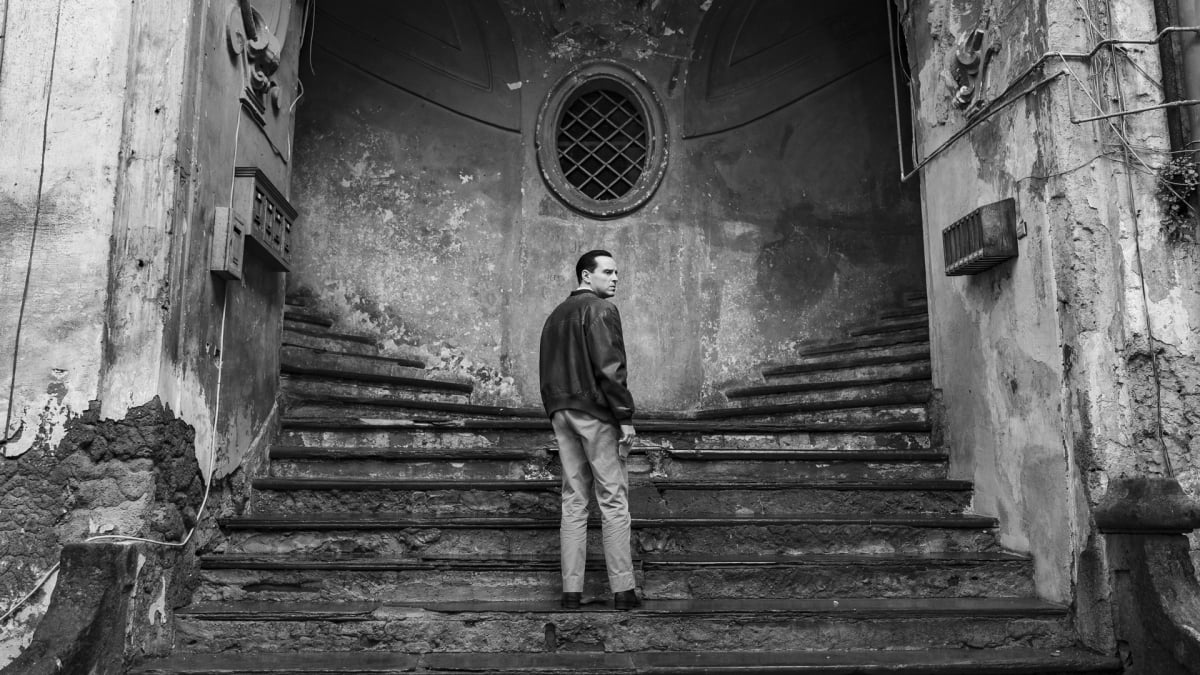Entertainment
Why is Caravaggio so important to Netflix’s ‘Ripley’?

It’s impossible to watch Netflix’s Ripley and ignore the Caravaggios. Don’t even try.
They loom large through Steven Zaillian’s exquisite adaptation of Patricia Highsmith’s novel, which both sticks to the source material with elegant ferocity and finds suitable moments to make its own mark. Across the eight-episode show, the eponymous anti-hero Tom Ripley (an excellent Andrew Scott) absorbs the cultural keys to the social kingdom on his identity theft quest, including the art the fancy folks apparently like — and that means Michelangelo Merisi da Caravaggio.
(And yes, dear reader, as an avid TV fan and Ripley enthusiast, I’m about to wave my art history degree at you. I’m still in debt for it; let me at least flaunt it.)
The target of his obsession, Dickie Greenleaf (Johnny Flynn), declares his adoration for the 16th century Milanese painter in the very first episode. Attempting to be something of an artiste himself, Dickie casually collects works by Spanish 20th century icon Pablo Picasso and tries his hand at abstracts, doing one of these things better than the other. Taking advantage of his proximity to cultural cornerstones like Rome, Dickie also loves himself a grand Italian master; he gravitates towards Caravaggio, whose works turn up again and again in the series.

Credit: Philippe Antonello / Netflix
Of course, as Tom absorbs Dickie’s identity throughout the series, so too does he become a Caravaggio fan, circling the artist’s must-see works in every city he visits. He even buys himself a beautiful hardcover catalogue of Caravaggio’s works, so he can study them up close in the comfort of his Venetian palazzo.
Why is Caravaggio used in Ripley, of all artists?
The thing is, novelist Patricia Highsmith never referred to Caravaggio’s works in her book, only mentioning in passing that Dickie owns a book of Quattrocento art (15th century Italian art, or early Renaissance, so before Caravaggio’s time). Art serves as newfound love for Tom in the book, as Highsmith writes, “He had learned a lot about painting, even in trying to copy Dickie’s mediocre paintings. At the art galleries in Paris and Rome he had discovered an interest in paintings that he had never realized before, or perhaps that had not been in him before.”
In Ripley, Zaillian places great importance on Caravaggio’s works, not only using the Baroque artist’s repertoire to expand upon his characters’ tastes, but also to draw comparisons with the inner workings of his protagonist.
Another major theme of the show is repressed sexuality. Historians have long debated Caravaggio’s sexuality, and today he’d probably be considered bisexual. Caravaggio’s works overtly eroticise the male figure, notably his homoerotic representations of Biblical figures like John the Baptist and mythological figures like Bacchus and Cupid. Caravaggio’s works have influenced gay male artists such as Robert Mapplethorpe and Derek Jarman, and would undoubtedly have quite the influence on one Tom Ripley, a closeted gay man in the ’60s.

Take me to this corner with a Caravaggio catalogue and leave me forever.
Credit: Philippe Antonello / Netflix
Caravaggio was famed for the brutal, bloody realism in his paintings, all rendered with chiaroscuro (an Italian term meaning light-dark) and tenebrism (from the Italian tenebroso, meaning darkened and obscured) — a technique Ripley also wields through its black-and-white cinematography and commanding use of light and shadow. Director of photography Robert Elswit shows every last detail of David Gropman’s production design in high contrast, with the Ripley lighting team obscuring and revealing vital clues, intensifying reactions, and capturing the elegance of Italy all through tenebrist and chiaroscuro techniques.
But the artist himself proves a perfect artist for Tom to admire in Ripley, beyond Dickie’s influence. Caravaggio gained a reputation for violence off the canvas, reportedly quick to anger, getting into fights on the regular, and even being accused of murder; it’s no surprise that Tom Ripley stans.
Here’s what London’s National Gallery has to say about Caravaggio’s…attitude:
According to one of his biographers: ”after a fortnight’s work he will swagger about for a month or two with his sword at his side and with a servant following him, from one ball-court to the next, ever ready to engage in a fight or argument, with the result that it is most awkward to get along with him”. (The sword was illegal — as with guns today, one had to have licence to carry arms.) Caravaggio was arrested repeatedly for, among other things, slashing the cloak of an adversary, throwing a plate of artichokes at a waiter, scarring a guard, and abusing the police.
When “throwing a plate of artichokes at a waiter” is your lightest offence, you’re probably a bit of a nightmare.
Which Caravaggio works are shown in Ripley?
Zaillian chooses to only really feature Caravaggio’s Biblical commissions, avoiding his famous work Narcissus. While this work about a man in love with his own reflection might seem suitable for Ripley, the director possibly sought to avoid associations of autoeroticism — Tom Ripley’s obsession is with others, not necessarily with himself.
Here’s a list of the works you can see in the show, and which episode they appear in — there’s a few spoilers in here.
The Seven Works of Mercy
Dickie takes Tom to see his first Caravaggio in Naples during episode 2, The Seven Works of Mercy, which is displayed in the church of Pio Monte della Misericordia. It’s a representation of seven acts of mercy, ranging from feeding the hungry to giving drink to the thirsty. Dickie shows Tom this painting in the same episode as his grand act of charity, helping a robbed woman get a cab.
The Inspiration/Calling/Martyrdom of Saint Matthew
In episode 4, when Tom makes it to Rome and begins absorbing Dickie’s identity, he makes sure there’s a Caravaggio visit on his list to begin the process. He heads for the church of San Luigi dei Francesi, where he stops in the Contarelli Chapel. There are actually three Caravaggios in there — The Inspiration…,The Calling…, and The Martyrdom of Saint Matthew — all of which get multiple appearances throughout the series.
In episode 8, Tom is flicking through his catalogue of Caravaggios in Venice studying The Calling of Saint Matthew, right before he’s about to be interrogated by Inspector Ravini (Maurizio Lombardi) as Tom Ripley not as Dickie Greenleaf. A work of shadow and revelation, it’s a fitting work for Tom to study right before he turns off all the lights and adopts a disguise.
David with the Head of Goliath
This is probably the greatest inclusion of a Caravaggio work in the series, the painting of the story of David and the giant Goliath, which Tom visits in the Galleria Borghese in Rome. Tom wanders through the gallery, listening to a tour guide describe Caravaggio’s last year of his life in 1610, when he painted this piece.
“In the painting, Caravaggio links the killer and victim by portraying David as compassionate, even loving, in the way he gazes at the severed head of Goliath,” the tour guide says. “And he made this bond even stronger by using himself as the model for both. Both are Caravaggio’s face. Young and old.” A self portrait of a killer and victim being one and the same? It’s exactly how Tom Ripley sees himself, and the director keeps bringing back glimpses of the work, especially after Tom’s head-bludgeoning murder of Freddie Miles (Eliot Sumner).
The Nativity with Saint Francis and Saint Lawrence
In episode 7, on his trip to Palermo, Tom visits the Oratory of Saint Lawrence, where this Caravaggio sits on the altar. The thing is, this Nativity scene was actually stolen in 1969 — around the time Tom visits it in the series. Tom Ripley, did you steal this Caravaggio?
The Crucifixion of Saint Peter
This high-drama work was painted in 1601 for the Cerasi Chapel of Santa Maria del Popolo in Rome, but we see it in the series finale of Ripley in the studio of none other than Caravaggio himself in a historical flashback (more on that below).
The Madonna and Child with St. Anne (Dei Palafrenieri)
Also in the finale flashback, this work sits above a candlelit mantlepiece in the Palazzo Colonna in Paliano. This domestic setting isn’t where the work was commissioned for — that would be St. Peter’s Basilica in the Vatican — but it’s now in the Galleria Borghese. The work shows the child stepping on a snake, a visual the episode will keep coming back to, possibly representing the stamping out of sin. Good luck with that, Tom.
Mary Magdalene in Ecstasy
It’s a blink-and-you’ll-miss-it moment, but you can spot this work in Tom’s Caravaggio book in episode 8, when he’s flipping through it. The work has stirred up all kinds of debate over authenticity, which is a fitting element in this series.
Sacrifice of Isaac
This one’s an overt thematic moment for Tom, a depiction of the Old Testament story of Abraham killing his son Isaac. This one comes at a time in episode 8 when Tom needs to kill off his Dickie Greenleaf identity in case he loses his own.
What’s with the final Ripley episode and the flashbacks?
The eighth and final episode of Ripley begins in the past. It’s a lavish descent into the history books that connects Ripley’s present with the legacy of Caravaggio himself (played by Daniele Rienzo) in the halls of the Palazzo Colonna in Paliano.
After we watch a group of soldiers marching into an artist’s studio, we see a man with a bloodied knife drinking a goblet of wine by the fire in a palazzo — it’s Caravaggio himself. Ripley is depicting the moment after the artist killed a man in 1606 and was sentenced to death; a tour guide in episode 4 actually tells this story in the Galleria Borghese. From the halls of the Palazzo Colonna, Caravaggio planned his escape to none other than where Tom Ripley’s journey to murder had began: Naples. Though Caravaggio died in Porto Ercole, north of Rome, Naples is significant to both men.
It’s a full circle moment, bringing Caravaggio to his end and Tom to his beginning, to the city of Naples, where Highsmith’s protagonist would start his journey toward the ill-fated Dickie Greenleaf and begin his path of violence and obsession. And ultimately, Caravaggio is the perfect artist for Tom to worship: a man of violence worshipped by a man of violence.
How to watch: Ripley is now streaming on Netflix.
-

 Business6 days ago
Business6 days agoTesla’s new growth plan is centered around mysterious cheaper models
-

 Business7 days ago
Business7 days agoUnitedHealth says Change hackers stole health data on ‘substantial proportion of people in America’
-

 Business5 days ago
Business5 days agoXaira, an AI drug discovery startup, launches with a massive $1B, says it’s ‘ready’ to start developing drugs
-

 Business5 days ago
Business5 days agoUK probes Amazon and Microsoft over AI partnerships with Mistral, Anthropic, and Inflection
-

 Entertainment4 days ago
Entertainment4 days agoSummer Movie Preview: From ‘Alien’ and ‘Furiosa’ to ‘Deadpool and Wolverine’
-

 Business4 days ago
Business4 days agoPetlibro’s new smart refrigerated wet food feeder is what your cat deserves
-

 Business6 days ago
Business6 days agoTwo widow founders launch DayNew, a social platform for people dealing with grief and trauma
-

 Entertainment6 days ago
Entertainment6 days agoTesla’s in trouble. Is Elon Musk the problem?




























